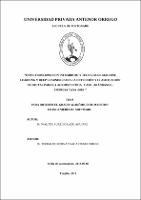Mostrar el registro sencillo del ítem
Espectroscopia con infrarrojo y técnicas de Machine learning y Deep learning para la detección y clasificación de frutas para la agroindustria. Caso: arándanos - Empresa Talsa - 2018
| dc.contributor.advisor | Sagástegui Chigne, Teobaldo Hernán | |
| dc.contributor.author | Lazo Aguirre, Walter Aurelio | |
| dc.creator | Lazo Aguirre, Walter Aurelio | |
| dc.date.accessioned | 2019-07-05T22:54:04Z | |
| dc.date.available | 2019-07-05T22:54:04Z | |
| dc.date.issued | 2019 | |
| dc.identifier.uri | https://hdl.handle.net/20.500.12759/5106 | |
| dc.description.abstract | ESPECTROSCOPIA CON INFRARROJO Y TECNICAS DE MACHINE LEARNING Y DEEP LEARNING PARA LA DETECCIÓN Y CLASIFICACIÓN DE FRUTAS PARA LA AGROINDUSTRIA. CASO: ARÁNDANOS - EMPRESA TalSA -2018 Las empresas comercializadoras de frutas, tienen la necesidad de optimizar la selección y clasificación de las frutas que comercializan, específicamente aquellos productos que se enviarán al extranjero donde se exige altos índices de calidad. Necesitan asegurar que el proceso selección y clasificación de frutas se realice con precisión para obtener un producto de alta calidad que satisfaga las exigencias de los clientes. Existen equipos que pueden realizar este trabajo de clasificación, pero son muy costosos para su adquisición al igual que su mantenimiento. Por lo expuesto anteriormente, la presente tesis desarrolla una propuesta basada en la aplicación de espectroscopia con infrarrojo cercano, Machine Learning y Deep Learning para la detección y clasificación de frutas para la agroindustria. Específicamente, se toma como caso de estudio, la clasificación de arándanos en la empresa TalSA. con la finalidad de establecer una herramienta alternativa para poder hacer la clasificación de arándanos, que permita reducir el costo, el tiempo y optimizar el proceso de detección y clasificación de Frutas. Para lograr lo antes indicado, se revisó el estado del arte de machine learning, deep learning, y deep neural networks, se revisó el uso de espectroscopia en el reconocimiento de frutas y sus propiedades, se analizó el proceso selección y clasificación de arándanos en la empresa TalSA. Luego, utilizando un equipo de espectroscopia infrarrojo cercano, NIR, se obtuvo el espectro de las muestras de arándanos. Con estos espectros, digitalizados, se realizó el entrenamiento de una red neuronal utilizando lenguaje de programación Python y la plataforma de Keras con TensorFlow. Luego, de realizado el entrenamiento, utilizó la red neuronal para realizar la etapa de testing, con los espectros NIR de nuevas muestras de arándanos, encontrándose que se pueden clasificar los arándanos con una exactitud del 92%, lo que permite confirmar la hipótesis de trabajo. Por el Br. Walter Aurelio Lazo Aguirre | es_PE |
| dc.description.abstract | INFRARED SPECTROSCOPY AND MACHINE LEARNING TECHNIQUES AND DEEP LEARNING FOR THE DETECTION AND CLASSIFICATION OF FRUITS FOR AGRIBUSINESS. CASE: ARANDANS - COMPANY TalSA -2018 The companies marketing fruit, have the need to optimize the selection and classification of the fruits they market, specifically those products that will be sent abroad where high quality indexes are required. They need to ensure that the fruit selection and sorting process is carried out with precision to obtain a high quality product that meets the demands of the customers. There are teams that can perform this classification work, but they are very expensive for their acquisition as well as their maintenance. For the above, this thesis develops a proposal based on the application of near infrared spectroscopy, Machine Learning and Deep Learning for the detection and classification of fruits for the agroindustry. Specifically, the classification of blueberries in TalSA is taken as a case study in order to establish an alternative tool to make the classification of blueberries, which allows to reduce the cost, time and optimize the process of detection and classification of Fruits. To achieve the above, the state of the art of machine learning, deep learning, and deep neural networks was reviewed, the use of spectroscopy in the recognition of fruits and their properties was reviewed, the process of selection and classification of blueberries in the TalSA Company was analized. Then, using a near infrared spectroscopy equipment, NIR, the spectrum of the blueberry samples was obtained. With these spectra, digitized, the training of a neural network was carried out using the Python programming language and the Keras platform with TensorFlow. Then, after training, it was used the neural network to carry out the testing stage, with the NIR spectra of new blueberry samples, finding that blueberries can be classified with an accuracy of 92%, which confirms the working hypothesis . By Br. Walter Aurelio Lazo Aguirre | en_US |
| dc.description.uri | Tesis | es_PE |
| dc.format | application/pdf | es_PE |
| dc.language.iso | spa | es_PE |
| dc.publisher | Universidad Privada Antenor Orrego - UPAO | es_PE |
| dc.relation.ispartofseries | T_MAEST.INGE_103 | |
| dc.rights | info:eu-repo/semantics/openAccess | es_PE |
| dc.source | Universidad Privada Antenor Orrego | es_PE |
| dc.source | Repositorio Institucional - UPAO | es_PE |
| dc.subject | Machine learning | es_PE |
| dc.subject | Deep learning | es_PE |
| dc.subject | Deep neural networks | es_PE |
| dc.subject | Espectroscopia | es_PE |
| dc.title | Espectroscopia con infrarrojo y técnicas de Machine learning y Deep learning para la detección y clasificación de frutas para la agroindustria. Caso: arándanos - Empresa Talsa - 2018 | es_PE |
| dc.type | info:eu-repo/semantics/masterThesis | es_PE |
| thesis.degree.level | Maestría | es_PE |
| thesis.degree.grantor | Universidad Privada Antenor Orrego. Escuela de Postgrado | es_PE |
| thesis.degree.name | Maestro en Ingeniería de Software | es_PE |
| thesis.degree.discipline | Maestría en Ingeniería de Software | es_PE |

